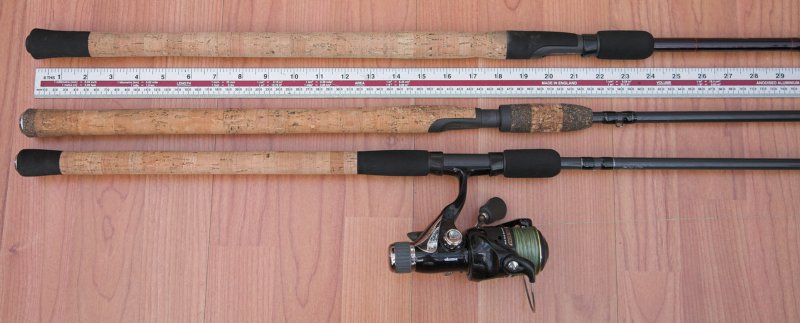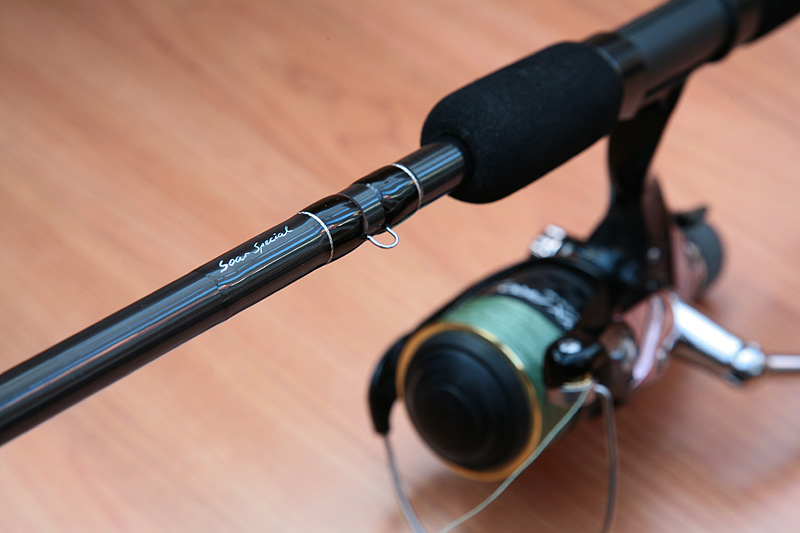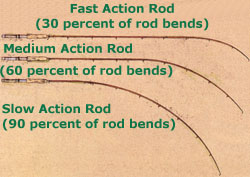Before you ask which rod/what test-curve read this...
By Gary (bb king) Staddon
By Gary (bb king) Staddon
This misnomer that is 'test-curve'
All too often people get hung-up on what test curve rod they have, or ought to have. There never seems to be an internet forum that doesn't have a thread from someone seeking advice, or giving advice, bleeting on about test curves. But what are they?
A test curve is a BIG red-herring, that's what it is.
A rod's measured test curve is a figure given to the amount of weight that, when applied to a rod will cause that rod to bend into a 90' curve.
Yep, that's it. That's all.
It bears no resemblance to what a rod is really capable of.
At this moment in time plenty of readers will be mumbling something under their breath like "twaddle", or something to that effect. Fine, but read on and learn.
Let's take a hypothetical situation; but answer in your own mind. What rod will be the most powerful between a 13' match rod and an 11' 1.25lb Avon rod?
How many of you plumped for the Avon? Chances are you'll be wrong. If you don't believe me, and you have access to both, I'll offer you a challenge. Thread up both rods and attach a spring balance to the end of the line on each in turn. Bend into both with as much gusto as you dare. You are not looking to determine a test-curve, as that is not 'real-world'. No, real-world is where you have a decent fish heading for a snag and you bend into into to stop it in it's tracks and that will require you put a much greater bend into the rod, down to the handle if you can/dare.
See, with an Avon, the action is 'all-through'. So, by the time the rod bent anywhere near to its full load it is bent down to the handle. This will give you a good 90' bend, which might be reflective of it's test-curve, i.e. 1.25lb of force. (Note the subtle difference there, more coming).
So how would the match rod have faired?
There is a good chance that the match rod will have a test-curve somewhere around 8 ounces. So, after a decent strike the rod would have achieved its' test-curve. BUT, as match rods tend to be more tip-actioned to progressive the bend at the point of test curve will still be within the top third of the rod. There is still two thirds of the rod with which we can apply a loading to. This is all IN ADDITION to any test curve. It could be that, by the time we have applied considerable (but safe) force to either the point where the blank 'locks-up' or we reach the handle, there may be 2lb or more of pressure exerted on our spring balance.
Are you surprised that the match rod came out on top? For many years my favourite barbel rod was an old 12' match rod. The top half soon bowled over but the real strength lay in the amount of force that could be exerted between the mid-point and the handle.
So you can start to see that action has perhaps a bigger part to play than test curve alone. The two do need to be considered hand in hand. But that is not to say that two progressive actioned 1.75lb rods will be as powerful as each other. Physical construction and tapers will determine that. Beyond action there are other factors which play a part, such as blank diameter, wall thickness and material strengths. This is why there are always new rods available on the market each year. There are just so many permutations to arrive at the end result - a fishing rod.
( I carried out this experiment using a custom built Harrison Avon 11' 1lb 6oz rod and a 12' MAP CFS float rod. It was not a scientific test, or approach, but I was able to comfortably hold a spring balance at 2lb 4oz with the avon rod, with a two-handed peak pull of 3lb. The float rod is reasonably soft and also through action. I was able to comfortably maintain 2lb 12oz on the spring balance with a 3lb 8o z peak pull. Rather than just pulling the tip around in a shop, if you were able to load up a reel and run line out to a spring balance to perform the above test you would have a far better idea of a rods' capabilities.)
Rod Function
Let's look at what we are asking the rod to achieve:
The first function that a rod has to perform is to carry a reel and line guides. We can use a wooden broom handle to achieve this aim, but we want something that is light enough to hold comfortably, a reel fitting that is secure and combined with a handle that again is comfortable. Line guides need to be of a type that are suitable for the type of line being used and which are able to carry the 'action' of the rod without creating an excessive change of direction at the line/guide interface. This will cause un-necessary friction which can damage the line through heat build up and cause scoring to poor quality linings.

(Top - Nash Barbel Elite, Bottom - Insight RB. Notice the difference in ring spacings especially nearer the top)

(Top - Nash Barbel Elite, Bottom - Insight RB. A closer look at the difference in ring spacing nearer the top)
Consideration should be given to rod length but is perhaps not as big an issue. Firstly, we will want it to be long enough to perform casting and striking functions. The longer a rod is the better it is to pick up line on a lengthy cast. So do you regularly cast big distances? We also need to consider our preferred swims. Do you fish 'Parrot cage' swims where a 12' rod will be a hindrance? Do you need length to get past nearside vegetation? A by-product of length is unfortunately weight. The longer you go, the more weight you add. If you intend to touch-leger or 'roll' baits all day long a light weight rod will be less tiresome.
The next function is to deliver our baited rig to our desired fishing point. Hitting big distances with big leads will require a rod with plenty of 'backbone' and length. Test-curve is again a misnomer to casting distance. Look at the thousands of match anglers who regularly cast 5-6oz swimfeeders across big rivers like the Trent or Severn using quivertip rods. These quiver tips might be rated between 2-4oz!! Hmmm. Have I got you thinking now? See, the real power lays in the rod blank as a whole, which we saw earlier, and that means more than any test-curve. If your preference is for small distances you might find that a short rod is more suitable. If you use swimfeeders or PVA bags then you will want a rod that is capable of handling this weight. However, if all you need to do is cast a swimfeeder or PVA bag no more than a few metres then you should find that even a soft rod will be able to manage to 'lob' this. You may loose a degree of finesse but that may be a trade-off you can live with.
Another area to consider, although this doesn't affect all styles of fishing, is whether or not the rod tip is going to be used for bite detection. The main significance being if we are going to use a quivertip or the standard rod top. If we are using a standard rod top is it going to be soft enough to indicate bites sufficiently. One point to also consider is that as soon as a quiver tip is bent over and the action of the rod proper is in play you are actually using a shorter rod. For instance, if you have a 12' rod of which the last two feet are a quivertip, as soon as you have a fish on it is being played below the 10' point of the rod. With a standard tip the full 12' of rod is in play.
That leaves us with the most important aspect of our rod to consider. Its' fish playing capability. In short, we use the rod when playing fish for two purposes. One is to exert an amount of pressure on the fish, through stiffness of the blank and by leverage. Stiffness can be achieved by wall diameter/carbon strength or by choice of taper. That means we can have a strong powerful blank that retains a through action, or a finer one but with a steeper taper leading to more power as the taper progresses. That is not to say that there are just the two types of construction. No, far from it, it is a minefield of choices out there. The second purpose is to act as a shock absorber. It is easy to see past this last point. If we use a high stretch monofilament line then we can afford to loose some absorbency in the rod. On the other hand, pre-stretched monofilament or braided lines have no stretch so the rod is required to perform greater if we are to avoid pulling out of the fish. Furthermore, if we regularly fish close in we are playing fish out on a much shorter line, therefore there is less line to stretch and again we will require more absorbency from the rod. Similarly, as the fish is going to be played a shorter distance it is going to be quite lively by the time we have it at the bank. This is where sudden last minute lunges are likely to be quite powerful as opposed to those from a fish that may have been fought 60 yards to the bank. Consequently, we will want a rod that has a very safe, soft action to prevent hook pulls or line breaks right at the net.
So we can see, two rods rated at 1.75lb test curve can have very different characteristics. A progressive actioned 1.75lb rod will still have more play left beyond its' rating compared to a through actioned rod of a similar rating. The through actioned rod will be more suited to a smaller river where its' inherent softness will be advantageous to hard fighting fish at close quarters, whereas a more progressive action will have more backbone to fish at greater distances. When choosing a rod though, compromise can be achieved by perhaps looking at a lower test-curve but progressive actioned rod, as its' initial power may seem soft it will have more 'deep-down' power than one of a higher yet 'all-through' action.
If you watch anglers as they play fish close to the net you will see better what the rod is doing. A tip action rod will be fairly straight in the blank with the tip folding over. Even if the rod has more power further down, the angle of fish - line - rod will prevent the rod from loading. A through action rod being softer will be more 'hooped' in comparison. At the net the through action rod will be most advantageous as it will absorb lunges better. On the other hand, if you are fishing 25-30yds or more out, the strength of a progressive rod will allow a greater degree of control due to its greater backbone.
Ergonomic Considerations.
There are many ways in which you can alter a rod to suit your individual style. Little touches which can make a difference. The difference in price between a good quality 'off-the-shelf' and a bespoke hand built rod are not as great as many people would think. The real benefit is in being able to have the rod crafted to your own taste, be it style of handle, size, quality and spacing of guides to blank colours.

(Top - Leslies Insight 12' RB, Middle - Nash 12' Barbel Elite, Bottom - Mark Tunley built Harrison Avon 11')
Personally, I prefer a short handle to a rod. I believe that the 2-4 inches off the butt allows for manouevering the rod around the body much better and saves the butt catching on my jacket. It also serves to give me just those few extra inches where I feel it counts, above the handle. Take this little test. Put a reel on one of your rods and measure how much handle extends beyond your elbow. The only time extra handle length is of any real benefit is if you really launch into a big cast with both hands.

Other nice touches that can be added are such things as hook keepers (again, I prefer mine to be located to the side, so that when I hold the rod across the back of my hand for baiting etc. I don't have the wire keeper digging in). You can add isotope holders, depth markers and all manner of simple tweaks to make your life simpler. If you feel that the balance of the rod is 'top-heavy' you can load the butt with a small amount of lead to counter-balance the outfit.
Summary
I hope that you will now see how choosing the right rod for you and how you intend to use it, require more than choosing one with the stated test-curve that is fashionable at the time. Asking fellow anglers what they use gives an indication of an option, but how would their styles fit in with your intended useage? You can't beat giving a rod a good old waggle, but the best place to do it is always on the bank! Tight Lines.
To add some more information to this article just to clarify...
I discussed how a match rod may prove to be more powerful than a 1.25lb through action Avon rod. Indeed, I went as far as to carry out a test before putting the article together, but even so, it would seem that one or two people still don't see hwo this could be true. Let me try to further explain.

As you will see above, there are various actions available to us. An Avon rod will fall into the 'slow action' category. As you can see in the above diagram, there is not much left in the blank once we are at 90 degrees curvature, as the curve extends down to near the rods handle. Putting more force into the rod will see that curve travel further down the handle but not by too much, so the rod will become fully loaded soon after its' designated test curve.
The medium and fast action rods have a lot more blank still left in reserve beyond the 90 degree bend. This blank can be made to bend by exerting more pressure. Generally, as long as the taper continues to widen, then this will equate to more power. Hence, a rod that achieves its' test curve further up the rod will retain more power further down the blank, making it more powerful than a slow actioned rod. As a closed season 'dabble', take out one or two of your rods and see how much force you can put on the rod. Bend into a spring balance and note what readings you get. (You'll need an assistant). First off, try with one hand on the rod and one on the reel handle, and secondly, by pulling up just above the handle as you would when trying to tame a biggie
Gary (bb king) Staddon 2006
